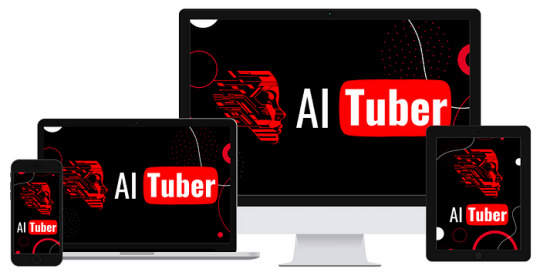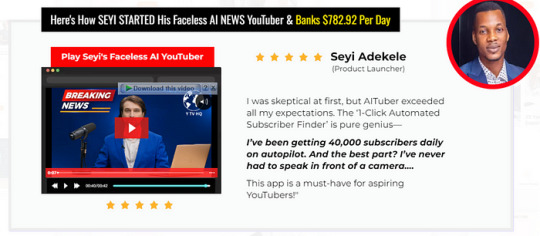#AI Tuber Upgrades
Explore tagged Tumblr posts
Text
AI Tuber Review – Create Viral YouTube Videos Without Showing Your Face
Welcome to my AI Tuber Review, This is a genuine user-based AI Tuber review, in which I will discuss the features, upgrades, price, demo, and bonuses, how AI Tuber can benefit you, and my own personal opinion. Brand New YouTube Approved AI App Transforms Anyone Into A Top Professional YouTuber Like Mr. Beast And Instantly Drives Millions of Views & Subscribers in Less Than 2 Minutes!
Are you ready to become the next YouTube sensation without ever showing your face on camera? With AI Tuber, you can! AI Tuber is the ultimate AI-powered tool that takes the hassle out of YouTube content creation. Imagine creating professional, engaging videos without ever having to be on camera. Sounds amazing, right? YouTube has become a dominant platform for creators to share their ideas, stories, and talents. However, building a successful YouTube channel requires more than just creativity; it demands time, consistency, and technical skills. AI Tuber is a revolutionary tool designed to simplify the content creation process for YouTubers by leveraging the power of artificial intelligence. With AI Tuber, creators can automate tedious tasks like video editing, scripting, SEO optimization, and audience engagement, allowing them to focus on producing high-quality content and growing their channel effortlessly.

What Is AI Tuber?
AI Tuber is a cloud-based AI-powered platform designed to streamline and automate various aspects of YouTube content creation. By leveraging advanced algorithms, AI Tuber can assist you in generating ideas, writing scripts, creating thumbnails, and even editing videos. The platform aims to empower creators of all levels, from beginners to seasoned professionals, to produce professional-quality content with minimal effort.

AI Tuber Review: Overview
Product Creator: Uddhab Pramanik
Product Name: AI Tuber
Launch Date: 2024-Sep-05
Launch Time: 11:00 ED
Front-End Price: $17 (One-time payment)
Official Website: Click HereTo Visit FE Salespage
Niche: Tools And Software
Support: Effective Response
Discount: Get The Best Discount Right Here!
Recommended: Highly Recommended
Bonuses: YES, Huge Bonuses
Skill Level Required: All Levels
Discount Coupon: Use Code “AITUBER5” To Get $5 OFF!
Refund: YES, 30 Days Money-Back Guarantee
>>>CLICK HERE TO GET INSTANT ACCESS NOW<<<
AI Tuber Review: Key Features of AI Tuber

Uddhab Pramanik, the creative mind behind AI Tuber. Pramanik is at the top of the tech industry because he is always looking for new ways to do things. He is leading the way in creating AI-powered app’s, software’s that open up new possibilities for users all over the world. Uddhab Pramanik is a tech pioneer who has helped move AI technology forward so that groundbreaking uses are no longer just a pipe dream but a real possibility for everyone.
Explore Pramanik’s impressive portfolio to see his list of successful launches, which includes OneAI, MusicBuddy AI, SiteRobot AI, Dropify AI, WP Defense, Explainer Video AI, MobiApp AI, FunnelBuddy AI, AiWizard, SendBuddy AI, Ink Buddy AI, Ai Channel, ViralDashboard A.I., NeoCloud, Vidzio, Ai Agent, Ai Songs. and many others.
AI Tuber Review: Key Features of AI Tuber
Transform Yourself Or Anyone Into A World-Class AI YouTuber Like Mr. Beast & Generate Millions Of Views & Subscribers On Complete Autopilot.
1-Click Automated Subscriber Finder Technology — Instantly Broadcast Your YouTube Videos & Shorts Directly To Your Niche Audience, Effortlessly.
Drive 10,000 To 50,000 Daily Subscribers On Complete Autopilot.
AI YouTube Avatar Creation: Design Custom Avatars With Dynamic Facial Expressions & Adaptive Lip-Syncing.
DFY Virtual Actors: Choose From Our Highly-Skilled 1000+ Done-For-You Virtual Actors For Your Automated YouTube Videos & Shorts!
Dynamic Facial Emotions: Tailor The Emotional Tone Of Your Videos With Precision, Ensuring Every Expression Perfectly Matches Your Script
Ai-Generated Videos: Effortlessly Create Captivating YouTube Videos And Shorts With AI-driven Scripts And Stunning Visuals.
Premium Voices: Transform Your Videos With AI-generated Voices That Sound 100% Human, Adding Authenticity And Appeal.
Multilingual Video Production: Expand Your Reach Globally With YouTubers Creating Content In Over 140 Languages.
Custom Backgrounds: Personalize Your Videos With Uniquely Designed Backgrounds That Elevate Your Brand’s Visual Appeal.
AI Logo Design: Instantly Craft A Professional Logo For Your Brand Or Channel, Giving You A Polished And Recognizable Identity.
AI Thumbnail Maker: Design Eye-Catching Thumbnails That Grab Attention And Make Your Content Impossible To Ignore.
AI YouTube Channel Name Generator: Get Perfect, AI-Generated Channel Name Suggestions That Resonate With Your Audience.
AI Video Title Suggestions: Receive Compelling, Search-Optimized Video Titles That Drive Clicks And Boost Discoverability.
AI Hashtags: Optimize Your Content’s Reach With AI-recommended Hashtags Tailored For Maximum Visibility.
AI Editing Suite: Edit And Refine Your Videos With Ease Using Powerful AI-driven Tools.
Interactive Video Elements: Enhance Viewer Engagement With Clickable Elements That Keep Your Audience Hooked.
Platform Integration: Seamlessly Upload Your Videos Directly To YouTube and Other Platforms, Saving Time And Effort.
Built-In Analytics Tool Lets You Track Your YouTube Performance.
Ai-Driven Live Chat Support For Real-Time Assistance.
Fire All Your Expensive Tools & Services.
Say Goodbye To Monthly Fees.
Commercial License Included — Create & Sell as Many Assets As You Like To Your Clients.
Newbie Friendly, Easy-To-Use Dashboard.
Iron-clad 30-Day Money-Back Guarantee.
AI Tuber Review: How Does It Work?
Transform Yourself or Anyone Into Faceless AI YouTuber In Just 3 Steps!
Step #1: Choose Your AI YouTuber
Choose Your AI YouTuber: Upload your photo, select someone else’s, or pick from our done-for-you AI avatars.
Step #2: Customize
Effortlessly tailor the look and facial expressions of your AI YouTuber with text commands or our drag-and-drop builder — no coding required.
Step #3: Publish & Profit
Instantly publish your AI-generated viral YouTube videos and Shorts while gaining 10,000 to 50,000 daily subscribers and sales on complete autopilot.
>>>CLICK HERE TO GET INSTANT ACCESS NOW<<<
AI Tuber Review: Can Do For You
AI Tuber Avatar Creation: Design custom avatars with dynamic facial expressions and adaptive lip-syncing.
AI-Generated Videos: Automatically create YouTube videos using AI-driven scripts and visuals.
Premium voices: Use Our AI To Create a 100% Human Like Voice for Your Video.
Multilingual Video Production: Create content in over 140 languages to reach a global audience.
Dynamic Facial Emotions: Customize the emotional tone of your videos to match the script.
Custom Backgrounds: Design and integrate personalized backgrounds into your videos.
AI Logo Design: Create a professional logo for your brand or channel using AI.
AI Thumbnail Maker: Design eye-catching thumbnails to attract viewers and make your content stand out.
AI YouTube Channel Name Generator: Get AI-generated suggestions for the perfect channel name.
AI Video Title Suggestions: Receive compelling, search-optimized video title ideas.
AI Hashtags: Optimize your content for discoverability with AI-recommended hashtags.
Script Management Tools: Manage and organize scripts within the app for easy video creation.
AI Editing Suite: Use AI tools to edit and refine your videos effortlessly.
Interactive Video Elements: Add clickable elements to enhance viewer engagement on YouTube.
Platform Integration: Seamlessly upload videos directly to YouTube and other platforms.
Verify Users Say About AI Tuber



AI Tuber Review: Who Should Use It?
Affiliate Marketers
Bloggers
Freelancers
Product Creators
Video Marketers
Content Creators
Website Owners
Agency Owners
Podcasters
Vloggers
Coaches/ Trainers
Authors
And Many Others
AI Tuber Review: OTO’s And Pricing
Add My Bundle Coupon Code “AITUBER30″ — For 30% Off Any Funnel OTO below
Front End Price: AI Tuber ($17)
OTO1: AI Tuber Unlimited ($47/$67)
OTO1: AI Tuber Enterprise ($37)
OTO1: AI Tube DFY ($67/$97)
OTO1: AI Tube YouTube Profit ($27)
OTO1: AI Tube Video Site ($37)
OTO1: AI Tube Unlimited Traffic ($27/$67)
OTO1: AI Tube Agency ($197/$297)
OTO1: AI Tube App Suite ($37)
OTO1: AI Tube Reseller ($197)
OTO1: AI Tube Whitelabel (297)
>>>CLICK HERE TO GET INSTANT ACCESS NOW<<<
My Own Customized Incredible Bonus Bundle
***How To Claim These Bonuses***
Step #1:
Complete your purchase of the AI Tuber: My Special Unique Bonus Bundle will be visible on your access page as an Affiliate Bonus Button on WarriorPlus immediately after purchase. And before ending my honest AI Tuber Review, I told you that I would give you my very own unique PFTSES formula for Free.
Step #2:
Send the proof of purchase to my e-mail “[email protected]” (Then I’ll manually Deliver it for you in 24 HOURS).
AI Tuber Free Premium Bonuses
Bonus #1: SendPal AI
The World’s First WhatsApp Smart Messaging App That Sends Unlimited “Mass Messages” To Unlimited Contacts For Unlimited Profits Tap Into 2.5 Billion Cell Phones With 96% Open Rates & Profit Instantly.
Bonus #2: GraphicX
Canva Like Graphics Editor With 1 Million+ Graphics To Start Your Own Graphic Agency & Sell To Hordes Of Hungry Customers.
Bonus #3: InfinityBlog
Next-generation A.I. platform in the world to create self-updating affiliate blogging and product review websites in hotly-competitive niches.
Bonus #4: VRStudio AI
New Ai Software Create & Sell Engaging Virtual Video In Just 3 Clicks From A Single Dashboard!
Bonus #5: MeetingHub
The Ultimate Solution To Connect & Collaborate For Live Video Chat | Meeting | Conference | Live Class, Online Training | Webinar | Podcast | P2P Chat Messaging | Group Chat | Screen Sharing | Real Time File Sharing.
Bonus #6: BookmakerPro
Children Story eBooks, Subjective eBooks, Fiction eBooks, Mystery eBooks, Business Related eBooks, Novels, Poems, Legal Documents, Project Report Presentations in 2500+ Niches.
Bonus #7: WebCreator 2.0
Futuristic Google TM Deep Mind A.I. Technology Creates Automated High-Converting Websites In Just 30 Seconds That You Can Sell For The Top Dollar In HOTTEST Niches.
AI Tuber Review: Money Back Guarantee
You’re In Safe Hands With Our 100% Risk-FREE, Iron-Clad 30 Day Money-Back Guarantee
If you buy AI Tuber and don’t get what you paid for, we don’t want your money. We’re on a mission to deliver a quality product to zero unhappy customers. And if we fall short in any way, then we don’t deserve your money. Well, if we don’t meet your expectations, then just let us know within 30 days for a full refund. Heck, as a kind gesture, we’ll even send you some extra software to skyrocket your business and sales like never before. So, either way, you only win.
>>>CLICK HERE TO GET INSTANT ACCESS NOW<<<
AI Tuber Review: Pros and Cons
Pros:
Time-saving: AI Tuber automates many tasks, freeing up time for content creators.
Efficiency: It streamlines the content creation process, improving productivity.
Quality: It can generate high-quality content, including scripts and thumbnails.
Cost-effective: It eliminates the need for hiring additional staff.
Creativity: It can inspire new ideas and enhance content quality.
Cons:
You need internet for using this product.
No issues reported, it works perfectly!
Frequently Asked Questions (FAQ’s)
Q. What exactly is AI Tuber?
The World’s First AI BRAND NEW YouTube Approved AI App Transforms Anyone into A Top YouTuber Instantly That Drive Millions of Views & Subscribers — In Less Than 24 Hours!
Q. Do I need some prior skills or experience to get started?
AI Tuber is 100% newbie-friendly with an easy-to-use dashboard.
Q. What happens if I don’t see results?
We’ve got you covered. If you don’t see your desired results with AI Tuber just let us know within the next 30 days and we’ll refund you every penny.
Q. What if I get confused along the way?
Don’t worry we have exclusive detailed video training for you that shows all the required steps.
Q. What if I get confused along the way?
Don’t worry we have exclusive detailed video training for you that shows all the required steps.
Q. Is This Compatible on Both PC, Mac, Android And iOS?
It works on any device.
Q. How Do I Lock-In My Discount?
Click the button below to get the AI Tuber at the lowest price.
AI Tuber Review: My Recommendation
AI Tuber represents a significant advancement in the field of YouTube content creation. By automating many of the time-consuming tasks involved in the process, AI Tuber can help creators of all levels produce high-quality content more efficiently. While it may not be a perfect solution for everyone, AI Tuber offers a valuable tool for those looking to streamline their workflow and elevate their YouTube channel.
>>>CLICK HERE TO GET INSTANT ACCESS NOW<<<
Check Out My Previous Reviews: AI Traffic Surge 2024 Review, UPLOAD n’ BANK Review, VinciPro AI Review, SoundWaves AI Review, Pulse AI Review, AI Pixel Perfect Review, and iSenseHUB AI Review.
Thank for reading my AI Tuber Review till the end. Hope it will help you to make purchase decision perfectly.
Disclaimer: This review is based on the information available at the time of writing and is intended for informational purposes only. The author does not claim ownership or affiliation with AI Tuber. The views expressed in this review are subjective and personal opinions. Readers are encouraged to conduct their own research before making any purchasing decisions.
Affiliate Disclaimer: Please note that this review may contain affiliate links. This means that if you click on a link and make a purchase, I may receive a small commission at no additional cost to you. This helps support the creation of high-quality content and does not influence the opinions expressed in this review.
#AI Tuber#AI Tuber App#AI Tuber Upgrades#AI Tuber Overview#AI Tuber Features#AI Tuber Review#AI Tuber Review WarriorPlus#AI Tuber Works#What Is AI Tuber#Buy AI Tuber#AI Tuber Price#AI Tuber Demo#AI Tuber Discount#AI Tuber Honest Review#AI Tuber Pricing#AI Tuber Exemple#AI Tuber FE#AI Tuber Pros#AI Tuber OTO#AI Tuber Preview#AI Tuber Scam#Get AI Tuber#AI Tuber Reviews#Purchase AI Tuber#AI Tuber Legal#Artificial Intelligence#AI#AI Tuber Benefits#AI Tuber Bonus#AI Tuber Bonuses
0 notes
Text
Everything we know so far about GPT-5

It has been more than half a year since OpenAI released ChatGPT in November 2022. Major AI enthusiasts have actively embraced the powerful capabilities of LLMs, but at the same time there are concerns about a series of security and ethical issues it has caused. With concerns and expectations coexisting, when will OpenAI release the next generation version of GPT-5, and what new breakthroughs will there be? In this issue, we bring you the latest developments about GPT-5, and put forward thoughts and prospects for the AGI behind GPT.
think
We try to put forward more divergent HE Tuber deductions and reflections based on the content of the article, and welcome exchanges.
Slow down and walk slowly, walking slowly creates depth. The powerful generation capabilities of LLMs have basically emerged. Amid concerns about safety and ethical issues, the slowdown of OpenAI has brought a certain catch-up period to the development of domestic large models. We also believe that the application layer is expected to emerge with definitions during this window period. Future application innovations.
Stronger input and memory, more reasonable pricing, higher factual accuracy and multi-modal processing capabilities are the expectations for the next generation of GPT-5 and other large models.
GPT-5 may be a huge shock, but it is also a drop in the ocean in the infinite galaxy.
In 2023, the use of the buzzword "AI" has increased significantly, and major companies are actively flexing their muscles and implementing tools that can instantly and amazingly react to simple text prompts from users. Amid the hustle and bustle, there is an AI chat tool called ChatGPT that is capable of conducting human-like conversations.
The currently free version of ChatGPT is based on OpenAI's GPT-3.5, which is a large language model (LLM) that uses natural language processing (NLP) and machine learning technology. After its release in November 2022, it triggered a wave of discussions about AI's ability to enhance workflows. In the process, it has also raised concerns that technology could take away human jobs — or pose a threat to humanity in the long term.
GPT-3.5 was replaced by GPT-4 in March 2023, which brought a number of improvements to chatbots, including the ability to input images as prompts and support for third-party applications through plugins. However, just a few months after the release of GPT-4, AI enthusiasts began to look forward to the release of the next version of the language model, GPT-5, and had huge expectations for its intelligent upgrade.
1. When will GPT-5 be released?
OpenAI released GPT-3 in June 2020 and launched an updated version in March 2022, which is called "davinci-002" internally. Then came the widely known GPT-3.5, also known as “davinci-003″, with the release of ChatGPT in November 2022, followed by the release of GPT-4 in March 2023.
Based on the trajectory of previous releases, OpenAI may not release GPT-5 in the next few months. This release may be further delayed due to the general sense of panic caused by AI tools like ChatGPT around the world.
GPT-4 has sparked multiple debates about the ethical use of AI and the harm it can cause to humans. Soon after, hundreds of tech leaders, educators, and celebrities, including Elon Musk and Steve Wozniak, signed an open letter calling for a moratorium on training systems “more advanced than GPT-4.”
Since then, OpenAI CEO Sam Altman has claimed at least twice that OpenAI is not working on GPT-5. In June 2023, Altman said at a press conference hosted by the Economic Times in New Delhi, India: "We still have a lot of work to do before we can develop GPT5. It will take a lot of time. We are very far from it." Previously, at an MIT event in April, Altman confirmed that OpenAI "will not be working on GPT-5 for some time." He added: " We are doing other things based on GPT-4, and I think there are various Safety issues need to be addressed.”
2. Stronger and more beneficial
Currently, GPT-4 can only handle requests for up to 8192 tokens, which is roughly equivalent to 6144 words. OpenAI briefly allowed initial testers to run commands with up to 32,768 tokens (approximately 25,000 words or 50 pages of content), which will be widely available in an upcoming release. GPT-4's current query length is twice that supported by the free version of GPT-3.5, and we can expect GPT-5 to support larger inputs.
It's worth noting that these larger queries also come with a corresponding price. While GPT-3.5 is free to use through ChatGPT, GPT-4 is only available to users of the ChatGPT Plus paid tier. Prices start at $20 per month, which might be a deterrent. As computing needs and chatbot proficiency increase, we may also see the price of GPT-5 increase. Currently, people can choose to use Microsoft's Bing AI Chat based on GPT-4, which is also free. However, you will be tied to Microsoft's Edge browser, where an AI chatbot will accompany you as a "co-pilot" throughout your online journey.
3. Less hallucinations
In addition to being better at producing results quickly, GPT-5 is also expected to be better at factual accuracy. In recent months, we have witnessed multiple times in the output of ChatGPT, Bing AI Chat or Google Bard nonsense - often technically called "hallucinations" because these models are built using limited and outdated data sets for training. For example, the free version of ChatGPT, which is based on GPT-3.5, only contains information through June 2021, so it may give inaccurate answers when asked about events after that date.
In comparison, GPT-4's training data set is more extensive, although these data are still only available as of September 2021. OpenAI points out the subtle differences between GPT-4 and GPT-3.5 in everyday conversations. GPT-4 also performs better on many tests, including the Uniform Law Examination (UBE), Law School Admissions Test (LSAT), Advanced Placement Calculus, and more. Furthermore, it surpassed GPT-3.5 in machine learning benchmarks not only in English but also in 23 other languages.
OpenAI claims that GPT-4 suffers from far fewer "hallucinations" and improves performance by 40% over GPT-3.5 in its "internal adversarial factual evaluation." Additionally, GPT-4 is 82% less likely to respond to "sensitive requests" or "prohibited content" such as self-harm or medical inquiries. Despite this, GPT-4 exhibits various biases, but OpenAI says it is improving existing systems to reflect common human values and learn from human input and feedback.
Eliminating GPT-5's erroneous responses will be key to its wider use in the future, especially in critical areas such as medicine and education.
4. Multi-modal capabilities
Little is known about GPT-4 beyond September 2021, but it has recently gained beta ability to connect to the internet through a dedicated web browsing plug-in update. Microsoft Bing AI chat, based on OpenAI's GPT and recently updated to GPT-4, already allows users to get results from the Internet.
While this means getting more up-to-date data, you may receive results from top-ranking, unreliable sites that use illegal SEO tricks to get high rankings. How these AI models can counter this situation and get reliable results quickly remains to be seen. This may also be one of the areas that needs improvement in OpenAI's future models, especially GPT-5.
In addition to web searches, GPT-4 can also use images as input for better context. However, this is currently limited to a research preview and will be rolled out in subsequent upgrades to the model. We can expect future versions, especially GPT-5, to gain greater ability to handle various forms of data, such as audio, video, etc.
Meta recently announced details about its multimodal AI model ImageBind, which can handle six different types of data: text, images, video, audio, depth, and heat maps. It is not difficult to predict that by the time OpenAI releases GPT-5, it will also have made progress in this area, making it more useful in a variety of work areas, not just as a chatbot or AI image generator.
5. Expectations and concerns about general artificial intelligence (AGI)
Artificial General Intelligence (AGI) refers to the ability of machines to understand, learn and apply any other intelligent tasks that humans can do. This means that AGI is capable of learning and decision-making across domains compared to existing specialized AI such as facial recognition or chatbots. The arrival of AGI has generated huge expectations in the technology sector, but it has also raised many concerns.
Part of the anticipation stems from AGI's potential. If machines could perform any job that humans are capable of, this could have a significant positive impact on society, including automating arduous labor, solving complex problems, and perhaps even opening up entirely new areas of innovation.
However, concerns about AGI are equally strong. First, if AI can do anything humans can do, many people's jobs may be replaced by automation, leading to massive unemployment. Furthermore, if AI decision-making becomes more effective than humans, they could potentially replace human roles in many key areas, including government decision-making, healthcare, and the military. This could raise significant social and ethical issues, especially if the AI’s decisions are inconsistent with human values.
The complexity of these issues has fueled considerable debate, including the moral and ethical responsibilities of AI and how we develop appropriate rules to govern this powerful new technology. In the coming years, as AGI technology advances, these questions are likely to become more pressing.
References:
Author: Vela, Yihao, Leo
Source public account: SenseAI (ID: gh_a54fc6d3826c); pay attention to the global AI frontier, enter technology startups, and provide multi-dimensional thinking for the industry.
This article is published with the permission of Everybody is a Product Manager cooperative media@SenseAI. Reprinting without permission is prohibited.
The title picture comes from Unsplash, based on the CC0 agreement
The opinions in this article represent only the author's own. The Renren Product Manager platform only provides information storage space services.
0 notes
Text
The digital people of the metaverse are already showing signs of full-scale outbreak.

In the field of the metaverse, digital humans HE Tuber are considered a relatively advanced technology, and many typical cases have emerged.
"Liu Yexi", who debuted under the label of "a virtual beauty expert who can catch monsters", is a relatively eye-catching existence among digital people. On short video platforms, her works have received tens of millions of likes. In 2021, It can be said that he is a phenomenal digital person. With the huge attention, "Liu Yexi" pointed out a bright prospect for commercial cooperation, which is to use this as a traffic entrance for commercial cooperation . Because of their fashion and freshness, digital people are more likely to have an out-of-circle effect than real people, and are favored by many companies, especially companies targeting young people, who often prefer digital people.
Baidu also launched the digital human Xijajia. Not long after his debut, Xijia became the first virtual recommendation officer for McDonald's products, and then successively landed on naked-eye 3D large screens in Chengdu and Dalian. In CCTV News' first "Super Release" "AI deep cultivation, all things grow - Baidu World 2022" online conference, Xijia also appeared as the AI planning officer and host of the conference, which fully reflected the role of digital people in various fields. Plasticity and adaptability.
Live streaming, singing and dancing, hosting events, image endorsements... The application prospects of digital people are extremely broad, and these applications have already been implemented, rather than just an expectation. Let us return to the value of digital humans in the metaverse, which is to undertake the production and transmission of information . For metaverse links such as "people-things-field", digital people are well-deserved core digital assets and elements. Various industries can be empowered by it and inspire more creativity.
The Toubao Research Institute has given a forecast that is very optimistic about the future development of virtual digital humans. It is estimated that its market size will reach 270.3 billion yuan by 2030, among which identity-based virtual humans will dominate the future development. Realistic progress also confirms such predictions. The launch of digital talents such as Liu Yexi and Xi Jiajia has been applied in scenarios such as live streaming and marketing, opening up business logic and realizing commercial monetization. This is also Promotes the positive cycle of digital people.
Compared with other technologies that only cost money but make no sound, digital people do have full potential.
3. The XR ecosystem of the Metaverse, Apple opens a window
What the Metaverse brings to humans is a digital life experience, and the level of this experience is limited by the level of hardware. From thin and light AR smart glasses to high-definition display VR all-in-one machines, many iterations of XR devices have brought us one step closer to realizing the metaverse .
Of course, XR is more than just a helmet or glasses. It covers VR/AR/MR and other related technologies. It is the next generation experience revolution and computing platform, an advancement in the integration of the digital world and the physical world, and an integration of computing power, connection and display. revolutionary upgrade.
Meta, Microsoft, Apple and other giants have invested heavily in XR, and have made a lot of progress in near-eye display technology, perceptual interaction technology, etc. It can be said that as the next generation hardware carrier, the current development status of XR is very similar to smartphones Entering the turning point stage of rapid development.
Just a few days ago, Apple launched its first-generation mixed reality head-mounted display device, Vision Pro. This is a device that is worn in the form of glasses. You can navigate with your eyes, click and scroll the screen with your hands, and give commands with your voice.
The revolutionary breakthroughs brought about by Vision Pro are surprising. It virtually eliminates latency, with new images arriving on the display in 12 milliseconds, faster than a human can blink. It even cooperated with Zeiss to customize optical inserts that can be magnetically attached to the lenses to facilitate services for myopia people. Such emerging hardware has a great boost in building the XR ecosystem.
With the help of corresponding hardware, XR will realize two major trends, from real to virtual and from virtual to real, and ultimately move towards the vision of the metaverse integrating virtual and real. Of course, it seems that after the hardware follow-up, XR needs to have a corresponding content ecosystem to truly retain users.
Apple released ARkit in 2017. At that time, it was not clear how far-reaching this move would be. However, through it, a large number of AR applications have emerged in the Apple Store. There are now tens of thousands of them, which has greatly enriched the entire XR content. ecology. What's more valuable is that these applications are by no means "generating electricity for love", but can actually provide benefits. According to Meta, as of February 2023, there are already 200 applications that can earn more than $1 million in revenue from Meta, and their number has increased by 44% compared with the same period last year. Moreover, Meta’s Quest series already has 6.37 million active players.
It can be expected that relying on 5G infrastructure and hardware support, the expansion of the XR ecosystem will gradually achieve the integration of virtual and real, forming a positive cycle of hardware-content-ecology . It can be said that the gradually evolving XR ecosystem is waiting for the arrival of a killer application.
0 notes
Text
Today’s world is Digital Marketing Trend-2021
In traditional marketing utilize traditional media like magazines and newspapers, in digital marketing, uses and digital media, such as social media or websites. ... Digital marketing just utilize this to its benefit by smartly connect in marketing communications into all and each digital path
In 2020 the world folks utilizing 95 million more mobile users.95 million more probable customers may be using a smartphone to search for and purchase products and things online.
Digital development hasn’t paused reached its peak point. As it continues to develop marketers carry on to discover new more paths to reach their audience
This #1digital marketing trend on list .70% of internet users have interacted with all chat boat platforms and solving questions through multiple apps and website Here look at some most

Popular trends in marketing 2021
Video Marketing
Video is the rapid growing form of content .like YouTube, tik-tok people are using video content in huge quantities. people consume visuals like images, illustrations, and videos better than content writing. On video so much content scroll through, it’s easier to watch a short video than read long articles, blogs, etc
According to a review by 50% of people have been impressed to purchased products and services after seeing the brand video, that why more marketers are using video marketing
In 2021 80% of marketers said that video content is a vital part of the content marketing strategy.
Conversational Marketing
Conversational Marketing is based on one-to-one interactions in real-time in multiple ways. It enables you to support Customer relationships increase your online customer experience by communicating and convert interaction online
Conversational marketing is related to talking to your customer when and where it’s convenient for them. That could be a live chat but it could also be Facebook, messenger, what app, telegram, Instagram another type of communication way

Data-Driven Marketing
The maximum marketers verify their data to better serve their customers. So many businesses earn more data than ever before. Customer data gives you access to an unbelievable amount of consumer vision that can be used for direct business opportunities.
Marketing data what tell you
How much traffic you website gets, how long they stay on the website and how many time they visit pages and website
What product and service sell better than others
How you organize our marketing campaign and attracting new people
How many customers are holding and how many are back up a certain period
What you are email open and click-through rates are
how social media content impress higher engagements rate are
how engaged people with website
Nostalgia Marketing
Why Nostalgia Marketing is most impactive is because it makes advertisements, promotions, and campaigns look more down-to-Earth and more reliable to the audience gathering for these types of marketing trend to be highly positive, as it is impacted by the positive emotions and memories of the users.
Many marketers using powerful emotions are in marketing inspirational of feelings of joy, freedom, pride and anger i.e very effective at influencing customer even more powerful
Social CRM is a developing trend
CRM systems have become more modern some have multiway programming for more effective lead generation and customer support service. Social CRM is collecting of social media ways into customer relationship management software
1) you can supervise their communication about your brand and competitors.
2)You can call the direct customer who is already following and engaging with you and social media are easier to sell to.
3)We can manage and respond to incoming customer service queries from your social media way
You-tube Marketing
Today’s popular platform is you-tube is call shorts also. it is the same kind of reels, where you can create short video content for 10 or 15second or under. With this famous short video content today. A YouTube video is a very good opportunity for all those who have their targeted audience on that platform. engaging 15 seconds videos is all it takes now grab the opportunity and attention of your viewers
International Ads
Digital marketing has opened up world doors for every business. you can run ads in different countries and world markets. this is one of the best digital marketing trends because you can get to increase your audience at the same or reduced costs, In some countries, you can also run ads at a much cheaper cost than your own country
Influencer Marketing
Influencer marketing is the more attractive word of mouth marketing that focusing a vital leader or personality to increase the brand promotion in the market. an influencer could be celebrities or you-tubers, Instagrammers with huge followings who can help to develop the word about the brand or business by social media. eduvogue is the best digital marketing institute in Mumbai

Chat Boats –
Chatbots are considered one of the top digital marketing trends in 2021, the AI-based technology makes use of immediate messaging to chat with direct customers, and with site visitors. It is designed to interconnect with direct customers by written or auditory methods.
Automated Email Marketing
As suggested, automated email marketing is sending emails to customers automatically based on schedules you set
Emails have always been the most reliable way of digital marketing, Promotional emails are the very surprising path to reach your potential customer and let them your company or organization have achieved a sale in next some days. personalized emails are a great way to bring back the attention of your customer and more engaged customer base

Digital marketing courses
Marketing techniques like search engine optimization (SEO), pay-per-click advertising(PPC), and social media marketing can prove to be beneficial, SMO( social media optimization), Google Adwords, Google Analytics, Google search console. you can start your blog or social media identity. Search engine optimization proposals companies an opportunity to grow their businesses
Massive Demand For Digital Marketers.
Marketing is a very vital part of a business's growth. some folks may not agree, and say that product upgrading is the most important. The sudden insight of smartphones, personal computers, and the internet to the masses has changed the media consumption and buying behavior of consumers. Traditional marketing systems are no longer sufficient to reach customers. Eduvgue provide digital marketing with a certificate

For More Details Contact on below link-https://forms.gle/sDxRKtc72UVMefQr8
#EduvogueJobGuaranteeCourses#Jobguaranteecourses#Jobs#Job jobvacancy#businessopportunity#digitalmarketing#fresher
0 notes